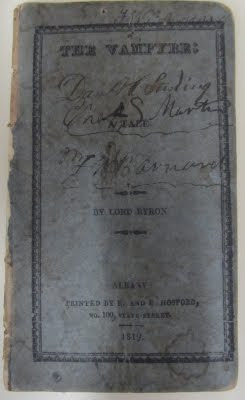With the oppressive heat and humidity of a Philadelphia summer bearing down on us, our fall Dracula festival seems very far away. But I am excited about a recent addition to our collection of supernatural stories–an early American printing of John Polidori’s The Vampyre. The Vampyre was the first English vampire story and established many conventions of vampire literature, including the linkage of sexuality and violence. It is unknown if Bram Stoker ever read Polidori’s story, but it is clear that he was familiar with its motifs. You can find the full text via Project Gutenberg.

The story of Polidori’s tale of terror begins with a gathering of literary friends during the chilly summer of 1816–the “year without a summer.” On a June evening in a villa on Lake Geneva, Lord Byron read a collection of horror tales aloud to his houseguests: Mary Wollstonecraft Godwin, her husband-to-be Percy Bysshe Shelley, their companion Claire Clairmont, and Byron’s physician John Polidori. Byron then suggested they each write a new ghost story. Mary Godwin [Shelley] rose to the task and produced Frankenstein. Percy Shelley wrote the brief “Fragment of a Ghost Story”. Byron started but abandoned his “Fragment of a Novel,” and, inspired by Bryon’s fragment, Polidori produced The Vampyre.
The Vampyre was published in the New Monthly Magazine in 1819 and was attributed, wrongly, to Lord Byron himself. Polidori wrote a letter of explanation for the next issue, but the association with Byron was already established. Our American edition was also published in 1819 and included the erroneous attribution. The work went on to many further printings, stage productions, and even an opera by Heinrich Marschner. You can check out a very nice medley/explication of the opera on Youtube.
